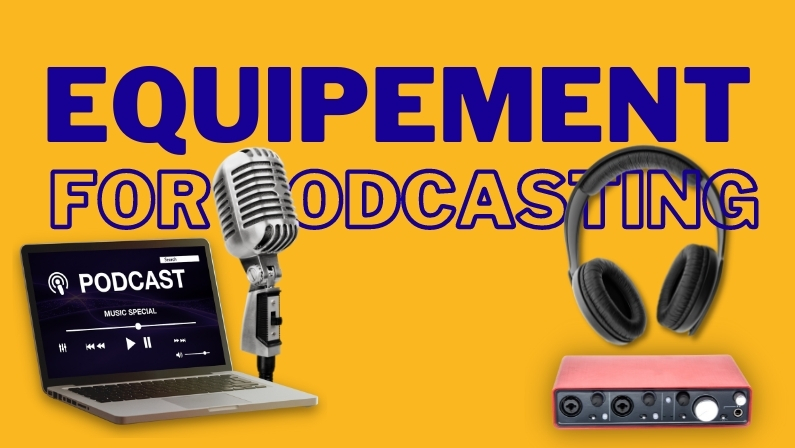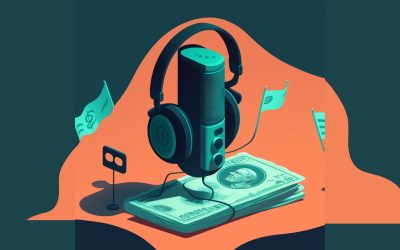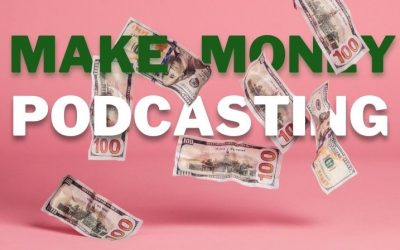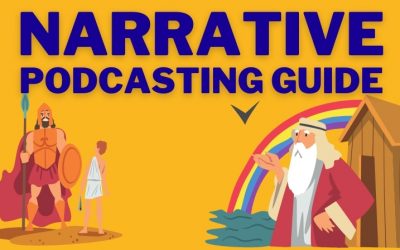So you would like to begin a podcast. Like social media, podcasts are becoming a natural medium for people to air out their opinions with the global community. Podcast series are growing wildly, with listeners looking for entertainment and educational content.
Navigating through the dozen podcast equipment options available in the market can be a hassle, especially for beginners. There’s a broad catalog of podcast gear out there, but only a handful of them are necessary to get the job done. You can add other miscellaneous equipment to your itinerary over time.
This article will focus on elementary recording equipment for a beginner-level podcaster, as well as other additional podcast gear you may garner as you aspire to go pro and build a complete podcast setup.
We are going to be referencing individual articles in this text on each piece of equipment mentioned. Follow the links to get thorough details.
List of Podcast Equipment for Beginners
Here are the four essential podcast equipment required to set up a podcast studio, not necessarily arranged in the order of priority.
- A microphone (Plus attachments like a microphone stand and pop filter or windscreen).
- A computer and recording and editing software.
- Audio Interface
- Headphones.
A Podcasting Microphone:
A microphone is undoubtedly an essential piece of equipment in podcast production. The caliber of your mic determines your sound quality, which eases the effort exerted in post-production.
We classify microphones according to how they connect to a computer, XLR, or USB. We also distinguish them based on the sensitivity and crispness of their sound, dynamic, or condenser.
- XLR Podcasting Microphones: These microphones have connectors with three prongs. You connect them through a mixer to a computer. We recommend these mics for recording multiple people simultaneously, perfect for a show that features guests and co-hosts and is commonly used in professional podcast setup.
- USB podcasting microphones: connected straight to the computer’s USB port. A preferred option for beginners since they are easy to set up and don’t require an audio interface.
- Dynamic podcasting microphones: Sacrifices reduced sensitivity to surrounding noise repression for a less crisp and thick sound. A recording gear favored by beginner podcasters with a makeshift home studio setup.
- Condenser podcasting microphones: Condenser mics are more sensitive devices to high-end frequencies and ambient noise, popular in recording studios.
Here are the best budget microphones for podcasting available in the industry. Check here for an in-depth look at the recording microphones listed below.
#1 Samson Q2U
Features
- Both USB and XLR microphones, suitable for new podcasters
- Plug and Play, easy to set up
- Dynamic recording microphone
#2 ATR 2100X
Features
- Both USB and XLR connector options
- Portable, can be easily carried around
- Good sound reproduction
- Condenser recording microphone
#3 Rode PodMic
Features
- XLR connector only.
- Comes with an audio interface
- Produces a balanced sound
- Sturdy design.
#4 Shure MV7
Features
- USB and XLR connectivity
- Condenser microphone
- Easy to set up
- Effective background noise cancellation
Best choice
The Shure MV7 is the best microphone for podcasting, designed to beat the shortcomings of condenser mics with its effective ambient noise cancellation technology.
A Computer for editing your podcast:

A computer is essential because it runs the digital audio workstation (DAW) responsible for producing your show, if you already have a good computer you can skip this section and move to the next one, you’ll find all the info related to the podcast editing software in this article.
DAW’s (Digital Audio Workstation) are audio processing software for recording and editing your sound to yield a furnished finish that gives elegance to your podcast.
Mac or Windows operating systems are both stellar options, as well as desktops or laptop computers. Base your verdict on whichever machine you find comfortable. Be mindful that DAW software like GarageBand and Logic Pro are only run on Apple products. Not to worry though, there’s a wide variety of options that run on Mac and Windows operating systems.
If you already have a While shopping for a new machine for your podcast setup, you should consider the following tech specification.
- Memory Space
- Processor
- USB port type
For beginner podcasters, the following specifications should suffice.
- 8GB of Random Access Memory (RAM)
- Built-in Solid State Device (SSD) storage
- Triple-core processor
Which is better for podcasting: Windows or Mac devices?
People are often split between which OS system would be more suitable for podcasting, Windows or Macbook computers. This choice depends predominantly on your budget and preferences, they both are great choices for the right kind of people.
Which DAW to choose?
Here’s a list of different DAW’s available and that can produce the highest outcome for your show:
- Audacity (free) compatible with Windows and Mac
- Garage band (free) Compatible with Mac only
- Adobe Auditon (paid) Compatible with Both
- Protools (paid) compatible with both
- Logic Pro (paid) compatible With Mac only
If you already have used one of those, stick to your guns. Use a DAW you know your way around so you can utilize the features of dedicated audio software to the max. This brings the best out of whatever production tool you’re using at the time.
For podcasters that are more familiar with Logic Pro and GarageBand, I’d suggest you purchase a Mac computer because they are exclusive to Apple.
ProTools is the standard for the music recording industry. Though this standard does not apply to podcasting, this software guarantees the highest level of Audio processing quality available in the market.
A Mac operating system delivers the best experience if you intend to produce high-level podcasts with ProTools software.
What’s Your Budget?
Apple is famous for designing high-end systems with state-of-the-art chips and software performance. This comes at a very high price in terms of cost. A beginner podcaster can settle for Windows systems with affordable specifications for decent audio production.
Our Verdict:
Podcasters striving for premium sound quality should go for the Mac. They have more options regarding Digital Audio Workstations and are robust computers with incredible processing power.
An Audio Interface:
They amplify the quality of your audio and provide multiple channels for recording more than one speaker simultaneously. Also, you cannot record using an XLR microphone without an audio interface. Digest this article on audio interfaces for more information.
Let’s look at some recommended audio interfaces that deserved inclusion in your podcast setup.
#1 Behringer U-Phoria UMC22
Features
- Affordable
- Portable with two XLR input channels
- Promising 48 kHz resolution for incredible sound reproduction
#2 Shure X2U
Features
- Affordable with a unique build
- Only compatible with USB mics
- Only receives audio input from one microphone at a time
- Plug-and-play, easy to install
#3 PreSonus AudioBox USB 96
Features
- Designed for music recording though warmly received by the podcasting community
- Two I/O recording channels
- 96kHz resolution, delivering pure sounds
#4 Focusrite Scarlett Solo 3rd Gen
Features
- Sturdy all-metal body build
- Broad gain range and higher dynamics
- USB Type-C connector
- Extra effects for brighter sound delivery
- Outstanding 192 kHz resolution
Best choice
The Focusrite Scarlett Solo 3rd Gen audio interface is your number one choice. It offers more than most audio interfaces and has a very high resolution which guarantees a precise sound reproduction.
Podcasting Headphones
It is worthwhile to invest in podcast headphones as optional as they may seem. Follow this link to check out the importance of headphones on a podcast setup and more details on the headphones mentioned in this article.
Audio Technica ATH-M50X Studio Headphone
Features
- Flat Frequency response, no boosted lower or higher frequencies
- Affordable price
AKG K 240 MK II
Features
- Semi-open back headset, comfortable to wear for long hours
- Pristine sound quality
Sony MDR7506
Features
- Wired closed-back headphones
- Closed ear design prevents the leakage of sound through its ear cups
Beyerdynamic DT 700 PRO
Features
- High resolution, maintaining the original quality of the audio
- Comfy earpads, allowing prolonged usage without earaches
- Rugged design
Bose QuietComfort 25
Features
- Effective ambient noise cancellation
- Comfortable to wear for long hours at a stretch
- Foldable, easy to carry around
Best choice
The Beyerdynamic DT 770 PRO checks in terms of comfort and efficiency. It is durable and produces a clear audio output.
What’s Next
After purchasing all the recording equipment you need and recording your episodes, the next step is finding a hosting service to get your podcast out there.
We have carried out all the necessary research. Read this article to discover the best hosting service for your podcast.



















0 Comments